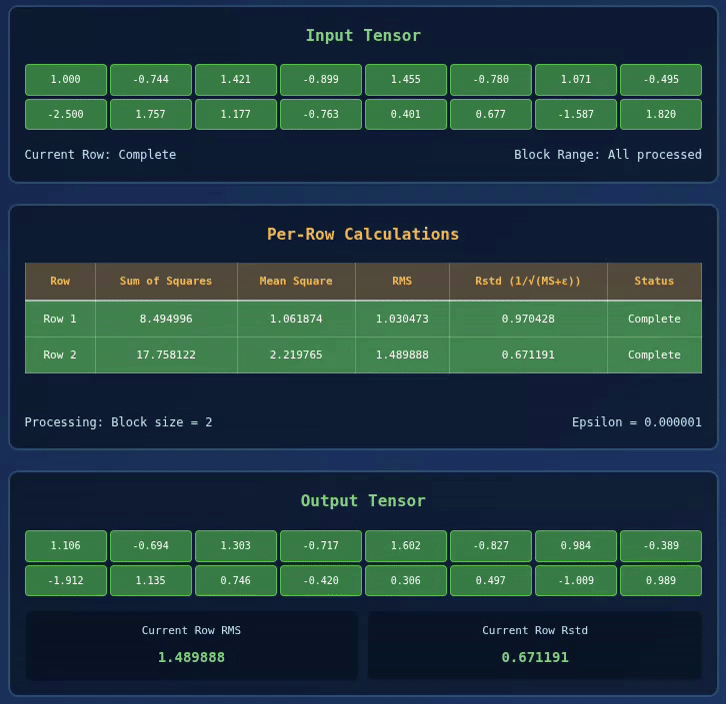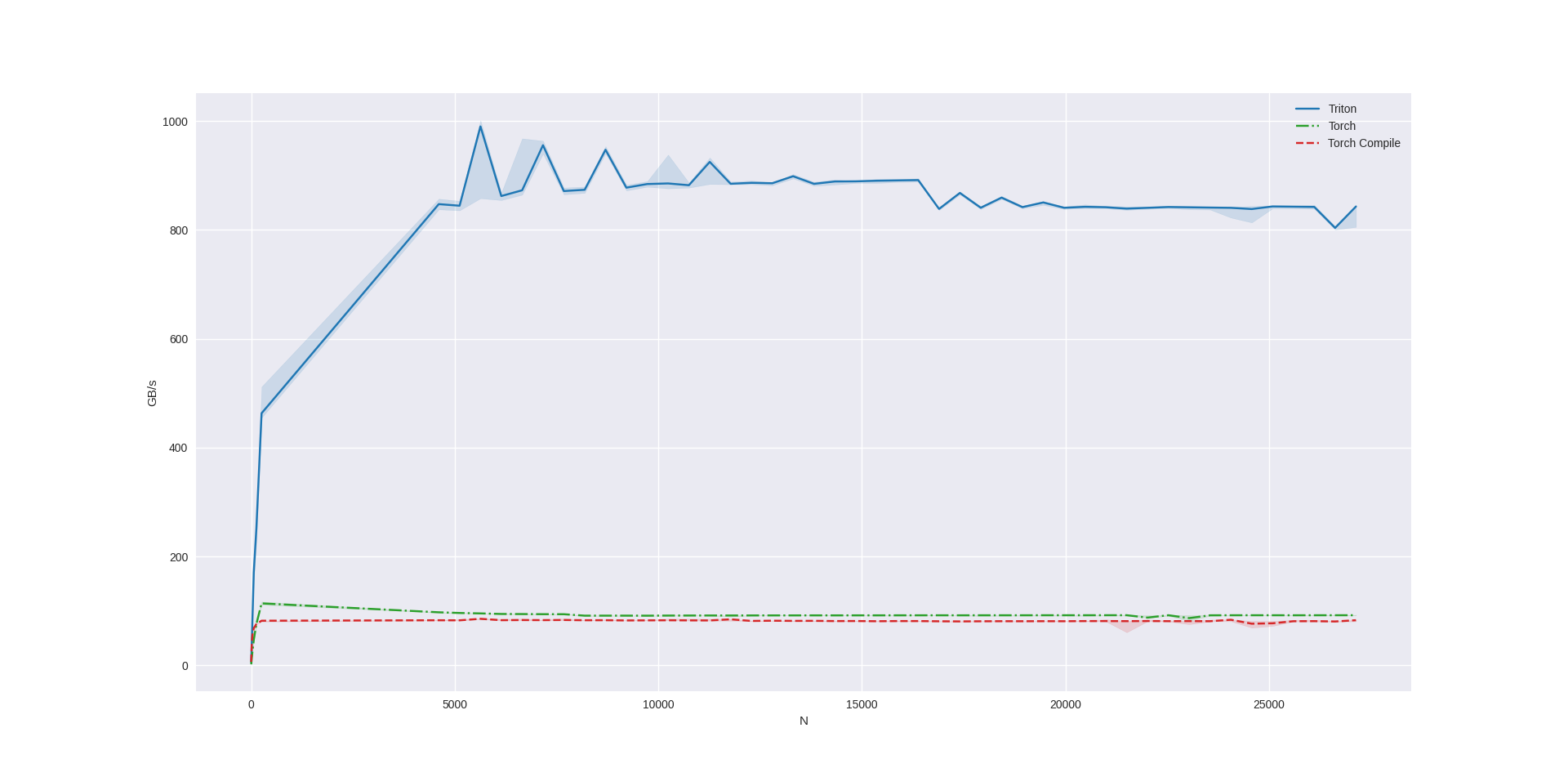Triton Kernels - RMS Norm
RMS Normalization Triton kernel implementation for LLMs
RMSNorm is a crucial component in modern transformer architectures. Most modern LLMs now user RMSNorm by default compared to the original versions where LayerNorm was more popular. Unlike LayerNorm, RMSNorm simplifies the computation by removing the mean centering step, making it more efficient for GPU implementation with Triton kernels.
What is RMS Normalization?
RMS Normalization normalizes inputs using only the root mean square of the values, without subtracting the mean. The formula is:
\[\text{RMSNorm}(x) = \frac{x}{\sqrt{\frac{1}{n}\sum_{i=1}^{n} x_i^2 + \epsilon}} \cdot \gamma\]Where:
- $x$ is the input vector
- $n$ is the dimension of the input
- $\epsilon$ is a small constant for numerical stability
- $\gamma$ (weight) is a learnable scaling parameter
RMSNorm Triton Kernel
In this post, we will walk through how a triton kernel for RMSNorm might look like, to simplify we will just consider forward only kernel for now. RMSNorm uses a combination of row-wise reductions (variance calculation) and point-wise ops (division, mult). Hence, BLOCKs will need to be processed such that we process each row at a time. (Just like softmax).
Let’s walk through a concrete example showing how RMS Normalization works in a Triton kernel with block-level processing:
Example Setup
Consider a 3×8 input matrix where each row needs independent RMS normalization with BLOCK_SIZE=4:
1
2
3
Row 0: [ 2.0, -1.0, 3.0, 0.5, -0.5, 1.5, -2.0, 1.0]
Row 1: [ 4.0, -3.0, 2.5, 1.0, -1.5, 0.0, -0.5, 2.0]
Row 2: [-1.0, 3.5, -2.5, 1.5, 0.0, -3.0, 2.5, -0.5]
Learnable Weights γ:
1
γ = [1.0, 1.0, 1.0, 1.0, 1.0, 1.0, 1.0, 1.0]
Step 1: Program ID Mapping
Each Triton program (CUDA block) processes one row independently:
1
2
3
row = tl.program_id(0) # Each CUDA block processes one row
Y += row * stride # Point to output row
X += row * stride # Point to input row
Block Assignment:
- Program 0: Processes Row 0
- Program 1: Processes Row 1
- Program 2: Processes Row 2
Step 2: Block-wise Sum of Squares Calculation
With BLOCK_SIZE=4, each row is processed in 2 blocks:
Row 0 Processing (Program ID 0):
1
2
3
4
5
6
# Triton kernel code for Row 0
_sum_sq = tl.zeros([BLOCK_SIZE], dtype=tl.float32)
for off in range(0, N, BLOCK_SIZE): # off = 0, then off = 4
cols = off + tl.arange(0, BLOCK_SIZE) # [0,1,2,3] then [4,5,6,7]
a = tl.load(X + cols, mask=cols < N, other=0.)
_sum_sq += a * a # Accumulate squared values
| Block | Columns | Values | Squared Values | Block Sum |
|---|---|---|---|---|
| Block 1 | 0-3 | [2.0, -1.0, 3.0, 0.5] | [4.0, 1.0, 9.0, 0.25] | 14.25 |
| Block 2 | 4-7 | [-0.5, 1.5, -2.0, 1.0] | [0.25, 2.25, 4.0, 1.0] | 7.50 |
| Total Sum of Squares | 21.75 |
All Rows Summary:
| Row | Sum of Squares | Mean Square (÷8) | RMS | Reciprocal RMS |
|---|---|---|---|---|
| Row 0 | 21.75 | 2.719 | 1.65 | 0.606 |
| Row 1 | 44.25 | 5.531 | 2.35 | 0.425 |
| Row 2 | 50.00 | 6.250 | 2.50 | 0.400 |
Step 3: RMS Calculation
1
2
3
sum_sq = tl.sum(_sum_sq, axis=0) # Total sum of squares for the row
rms = tl.sqrt(sum_sq / N) # Root Mean Square
rrms = 1 / (rms + eps) # Reciprocal RMS (for efficiency)
Step 4: Normalization and Weight Application
Now we apply the transformation y = γ × (x / RMS) in blocks:
1
2
3
4
5
6
7
8
9
# Triton kernel code for normalization
for off in range(0, N, BLOCK_SIZE):
cols = off + tl.arange(0, BLOCK_SIZE)
mask = cols < N
w = tl.load(W + cols, mask=mask) # Load weights γ
x = tl.load(X + cols, mask=mask, other=0.)
x_norm = x * rrms # Normalize: x / RMS(x)
y = x_norm * w # Scale: γ * x_norm
tl.store(Y + cols, y, mask=mask) # Store result
Row 0 Normalization (RMS = 1.65, rrms = 0.606):
| Block | Input Values | x × rrms | γ × (x × rrms) | Output |
|---|---|---|---|---|
| Block 1 | [2.0, -1.0, 3.0, 0.5] | [1.21, -0.61, 1.82, 0.30] | [1.21, -0.61, 1.82, 0.30] | [1.21, -0.61, 1.82, 0.30] |
| Block 2 | [-0.5, 1.5, -2.0, 1.0] | [-0.30, 0.91, -1.21, 0.61] | [-0.30, 0.91, -1.21, 0.61] | [-0.30, 0.91, -1.21, 0.61] |
Complete Output Matrix
After processing all rows:
1
2
3
4
Output Matrix Y (3×8):
Row 0: [ 1.21, -0.61, 1.82, 0.30, -0.30, 0.91, -1.21, 0.61]
Row 1: [ 1.70, -1.28, 1.06, 0.43, -0.64, 0.00, -0.21, 0.85]
Row 2: [-0.40, 1.40, -1.00, 0.60, 0.00, -1.20, 1.00, -0.20]
Full Kernel
1
2
3
4
5
6
7
8
9
10
11
12
13
14
15
16
17
18
19
20
21
22
23
24
25
26
27
28
29
30
31
32
33
34
35
36
37
38
39
40
41
42
43
44
45
46
47
48
@triton.jit
def rms_norm_forward(
input_ptr,
output_ptr,
weight_ptr,
rstd_ptr,
row_stride,
feature_dim,
eps,
BLOCK_SIZE: tl.constexpr,
):
# Map the program id to the row of input and output tensors to compute
row_idx = tl.program_id(0)
output_ptr += row_idx * row_stride
input_ptr += row_idx * row_stride
# ==== REDUCTION PART ====
# Compute variance (mean of squared values for RMS)
sum_of_squares = tl.zeros([BLOCK_SIZE], dtype=tl.float32)
for block_offset in range(0, feature_dim, BLOCK_SIZE):
col_indices = block_offset + tl.arange(0, BLOCK_SIZE)
input_values = tl.load(
input_ptr + col_indices, mask=col_indices < feature_dim, other=0.0
).to(tl.float32)
sum_of_squares += input_values * input_values
variance = tl.sum(sum_of_squares, axis=0) / feature_dim
reciprocal_std = 1 / tl.sqrt(variance + eps)
# Store reciprocal standard deviation for backward pass
tl.store(rstd_ptr + row_idx, reciprocal_std)
# === POINTWISE OPS ====
# Normalize input and apply weight transformation
for block_offset in range(0, feature_dim, BLOCK_SIZE):
col_indices = block_offset + tl.arange(0, BLOCK_SIZE)
valid_mask = col_indices < feature_dim
weight_values = tl.load(weight_ptr + col_indices, mask=valid_mask)
input_values = tl.load(input_ptr + col_indices, mask=valid_mask, other=0.0).to(
tl.float32
)
normalized_values = input_values * reciprocal_std
output_values = normalized_values * weight_values
# Write final output
tl.store(output_ptr + col_indices, output_values, mask=valid_mask)
Let’s see it in action
Below we have a visualization for 2 x 8 Tensor with BLOCK_SIZE = 2:
Interactive RMS Norm Visualizer
Explore how RMS Normalization works in Triton kernels with this interactive visualization:
🚀 RMS Normalization Triton Kernel Visualization
| Row | Sum of Squares | Mean Square | RMS | Rstd (1/√(MS+ε)) | Status |
|---|
Benchmarks
Let’s see triton benchmarks with our kernel implementation and compare it w.r.t. Torch and Torch Compiled versions. I have an RTX 4090 24gb, which has a memory bandwidth of 1,008 GB/s. Based on the benchmark, we are able to hit 80%is of the memory bandwidth which is typical – so seems like the kernel is performing really well.

